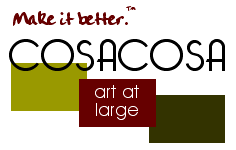



The tradition of art as a vehicle for social change and community-building is well established -- art can both inform and transform community. At a time when the social fabric of many urban neighborhoods is threatened by poverty, disease, and violence, communal art-making gives us the ability to create and envision possible solutions to our problems through collective action. Art can serve as an important source of intergenerational and cross-cultural communication, generating the power not only to transform community, but more importantly, the power to foment and inspire youth to be leaders and to see themselves as caretakers -- agents of change in the very communities from which they come.
Currently, there is a growing recognition of social drivers (economic, cultural, social and environmental factors that contribute to inequity) as the primary forces that fuel conditions like poverty, disease, violence, substance abuse, and urban decay. This realization, while not new, is being given serious consideration across a wide-range of disciplines which have begun to see the wisdom of countering negative social drivers through the creation of structural interventions to address the very root causes of societal ills.
This being the case, the education and empowerment of urban youth becomes a particular priority, integral to the future well-being of our communities. Art is especially suited to this task. Projects like COSACOSA’s Common Good initiative advance youth as full partners with their adult neighbors, all the while teaching them media literacy and problem-solving through art and art-making. Strategic planning for a public art project allows youth the opportunity to explore and understand more deeply problems which affect their neighborhoods -- and to brainstorm solutions as community leaders. Professional artists give youth access to new skills, ideas and role models. Art’s invaluable approach allows participants to tap into the social capital surrounding them, so that the remedies are not prescribed from a deficit perspective, but rather, from an asset-based one. By definition, Common Good entails uniting the best of what individuals and communities can offer -- with a grace and resiliency central to our very survival in the face of great odds. The Common Good initiative provides us an opportunity to revisit, sustain, and expand this work so central to the search for shared solutions to problems we face.
The bringing together of diverse communities to build both physical and temporal spaces through art -- and the process of art-making itself to address social concerns -- can initiate discussions around the interconnectedness of ourselves to community and environment and how we knowingly or unknowingly contribute to these social determinants. New media projects, like COSACOSA’s Common Good initiative, go one step further, offering means for broad cross-cultural sharing and dissemination of ideas, erasing or shifting geographical lines, both real and imagined, beyond boundaries of age, race, class, and gender.
Mahatma Gandhi said, "You must be the change you wish to see in the world." Art allows us to define and promote the common good as active participants in creating the process of change we want to see in both ourselves and in our communities.
Juan David Acosta’s work as a poet, writer, activist, and cultural worker appears in many literary journals and anthologies. Among the most notable are Mayrea, The Evergreen Chronicles, The Americas Review, American Poetry Confronts the 1990s (Black Tie Press 1990), The Limits of Silence (Asterion Press 1991), Poesida (Ollantay Press, 1995), and Floating Borderlands: Twenty Five Years of Latin American Poetry in The United States (University of Washington Press, 1998). Acosta has taught poetry and creative writing across the curriculum in a wide variety of educational settings. He is the co-founder of the Working Fund for Artists with AIDS and is the Coordinator of HIV/AIDS Prevention Programs for the City of Philadelphia Department of Public Health. Acosta serves on COSACOSA’s community-based Advisory Board.